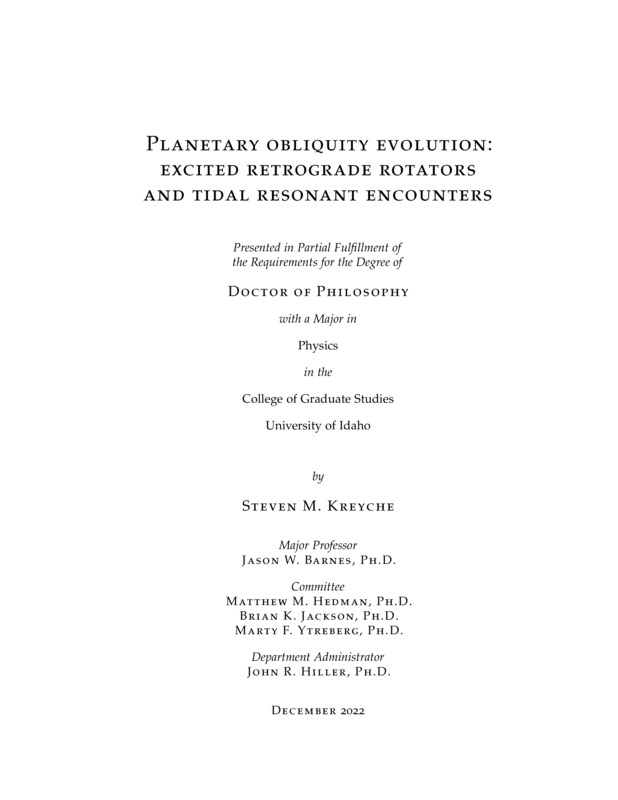Planetary obliquity evolution: excited retrograde rotators and tidal resonant encounters
Kreyche, Steven Mark. (2022-12). Planetary obliquity evolution: excited retrograde rotators and tidal resonant encounters. Theses and Dissertations Collection, University of Idaho Library Digital Collections. https://www.lib.uidaho.edu/digital/etd/items/kreyche_idaho_0089e_12421.html
- Title:
- Planetary obliquity evolution: excited retrograde rotators and tidal resonant encounters
- Author:
- Kreyche, Steven Mark
- ORCID:
- 0000-0002-7274-758X
- Date:
- 2022-12
- Keywords:
- Astrobiology Computational Astronomy Computational Methods Exoplanet Dynamics Exoplanet Tides Habitable Planets
- Program:
- Physics
- Subject Category:
- Astrophysics; Astronomy; Physics
- Abstract:
-
The search for extraterrestrial life along with our desire to understand the necessary conditions for the development of life are large motivators in the field of astronomy. Although the Earth remains as our sole data point, it seems overwhelmingly likely that either other Solar System bodies or distant exoplanets had, have, or will have the capacity to host life of their own. Nonetheless, the assessment of a world's potential for habitability is a complex problem that requires thorough study of many contributing aspects. One key aspect is the value and evolution of a planet's obliquity, or axial tilt, which sets the nature of its seasons and long-term climate by governing the distribution of solar flux across its surface. Although we enjoy a pleasant climate thanks to the Earth's stable moderate obliquity, other planetary bodies may be either even better off or severely challenged in comparison. In dissertation, I help build toward a more complete picture of habitability by studying planetary obliquity evolution with the use of numerical simulations of planetary systems. Beginning with Chapter 1, I provide a brief background of the dynamics that drive obliquity evolution and describe previous work that establishes our current understanding moving forward. In Chapter 2, I discuss a threatening secular spin-orbit resonance that can destabilize the obliquities of retrograde rotators (planets with obliquities greater than 90 degrees). Next, in Chapter 3 I introduce SMERCURY-T, a tool that allows for the study of planetary obliquity evolution under the influence of tidal forces. Finally, in Chapter 4 I apply SMERCURY-T to study the tidal obliquity evolution of a moonless Earth and a potentially habitable early Venus. Each of these chapters provides wider contributions past their individual results by urging direction to future studies, releasing publicly available software, or identifying trends and process that may be important to the obliquity evolution of extrasolar planets. These findings can ideally be applied to such exoplanet systems in the future once further our capability to detect and characterize their spin states.
- Description:
- doctoral, Ph.D., Physics -- University of Idaho - College of Graduate Studies, 2022-12
- Major Professor:
- Barnes, Jason W
- Committee:
- Hedman, Matthew M; Jackson, Brian K; Ytreberg, Marty F; Hiller, John`
- Defense Date:
- 2022-12
- Identifier:
- Kreyche_idaho_0089E_12421
- Type:
- Text
- Format Original:
- Format:
- application/pdf
- Rights:
- In Copyright - Educational Use Permitted. For more information, please contact University of Idaho Library Special Collections and Archives Department at libspec@uidaho.edu.
- Standardized Rights:
- http://rightsstatements.org/vocab/InC-EDU/1.0/

